 The
Ranums'
The
Ranums'
Panat Times
Volume 1, redone Dec. 2014
Jacques-François Mathas marks some manuscripts of Marc-Antoine Charpentier with his personal paraphe:
New evidence about the transfer of Marc-Antoine Charpentier's
Mélanges to his nephews, Jacques Édouard and Jacques-François
Mathas, 1709
and
about how one individual used, or did not use,
his paraphe
For Catherine Cessac
"Two heads are better than one ...."
Prologue: some intriguing questions
On February 16, 2014, I received an email and some scanned images from Catherine Cessac, requesting my thoughts about annotations in several Charpentier manuscripts:
C'est la même main mais de qui? Est-ce bien le prix qu'on doit lire après le nombre de feuillets? ... Voici aussi ce qu'on trouve dans les Mélanges ... qui me paraît être de la même main et que je transcris ainsi: Le graveur [?] a les deux feuillets suivants de cette partition qui comprennent Egredimini...
Lastly, she wondered whether I could propose a date for these annotations.
This was intriguing. I had not noticed that these annotations exist.
The three annotations in question are in the upper left-hand corners of the final pages of three recueils. Two of the recueils, in Charpentier's hand, are preserved at the BnF, Rés Vmc Ms 27 and Rés Vmc Ms 28. In both books the feuillets ("pages") take the form of horizontal quarter-sheets. Manuscript 27 contains pieces written for the Dauphin's Musique: members of the Pièche family are mentioned, and its watermarks depict a closed royal crown. It dates from circa 1680. Manuscript 28 is on a different paper, apparently my paper E, which was used only between mid-1677 and December 1679.
I can't discuss the third recueil here, because it contains a discovery that Catherine Cessac (henceforth "CC") will make known to Charpentier scholars. I had never looked at that particular recueil, and I wasn't even aware that it might have some connection to Charpentier.
Here are the four images that CC sent me, with enlarged details:
Rés Vmc ms 27:

Rés Vmc ms 28: "25 feuillets, 35 sous":

The mystery recueil: "36 feuillets 3 lt":

Mélanges, vol. 23, cahier LVIII, fol. 40:

Answering Catherine Cessac's questions
The first step was to try to answer the question about whether the numbers might indeed indicate prices. CC's hypothesis seemed to be right on target: we own several old French books in which the blank sheet at the back bears a number accompanied by a sign that seemed to indicate sous or livres. In CC's images, the S lying on its side would logically represent sol or sou, while the small superscript, but unfortunately incomplete sign suggested the barred U commonly used to represent livre tournois. It nonetheless was essential to compare the signs in these images with the signs in my photocopies of early eighteenth-century death inventories.
All research is fortuitous. If I had reached for the inventory of a Parisian bookseller, or that of Marc-Antoine Charpentier's cousin Gilles, we might never have learned about Jacques-François Mathas's conduct in 1709, and we certainly would not have identified the person who wrote those additions. Luckily, my fingers grabbed the plump folder containing the death inventory of Marc-Antoine's lingère sister, Étiennette, who died on March 22, 1709. How fortunate it is that, back in the 1980s, when photocopies were very expensive, I didn't try to save money by picking up a pen and summarizing the contents of that inventory, as usual. There would have been no photocopies with which to compare CC's scans, and the tale that follows doubtlessly would never have been recounted.
The documents in the folder (1) about Étiennette Charpentier inform us that, late on March 22, 1709, seals began to be placed on the doors, armoires and locked storage places in the lodging above her shop, situated at the corner of the rue des Noyers and the rue des Anglais in the left-bank parish of Saint-Severin. Both the inventory and the scellé were conducted by a nearby notary, Jacques Guesdon of the rue Saint-Séverin. The inventory itself was begun on April 5 and continued until April 13. The bequests were paid in late April and throughout May.
As I flipped through the pages that enumerated Étiennette's property
and estimated the value of each item, my jaw dropped.
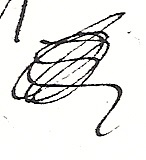 The
signs for sou and livre were identical to those in the
images sent by CC! The handwriting in Étiennette's inventory was
identical to the hand in CC's images! And the paraphe in
several of CC's images appears again and again in the papers of the
estate: it belonged to Jacques-François Mathas, Marc-Antoine
Charpentier's nephew!
The
signs for sou and livre were identical to those in the
images sent by CC! The handwriting in Étiennette's inventory was
identical to the hand in CC's images! And the paraphe in
several of CC's images appears again and again in the papers of the
estate: it belonged to Jacques-François Mathas, Marc-Antoine
Charpentier's nephew!
In other words, we can make three assertions that we could not make before Catherine and I began scrutinizing these annotations:
--- the annotations in CC's images were made between April 5 and April 13, 1709;
--- they were written by notary Guesdon's clerk;
--- and they apparently were made at the request, and in the presence of Jacques-François Mathas.
Before looking more closely at the motives that might have prompted Mathas to request these annotations and mark them with his personal paraphe, let us compare the handwriting in CC's four examples, with details excerpted from the pages written by the clerk.
A comparison of the annotations in the recueils of music, and the hand of Jacques Guesdon's clerk
Let's begin with the word feuillets, which appears in all four of CC's images (see "36 feuillets" on the image to the right). Next to it is "feuillet" as it appears in the inventory; and since the photocopy of the death inventory is not especially clear, I am also showing the name François, which begins with the same F as feuillet and ends with the same type of S.
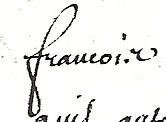

Next, let's compare the signs for sou/sol and livre.
They are the same. It is more difficult to be assertive about the
superscript sign after the 3 in CC's example, but the loop (see the tall
vertical image just below this paragraph) appears to be the lower half
of the sign for livre tournois.


In like manner, the numbers 2, 3, 5 and 6 are the same. Even the
clerk's tendency to sometimes put a crossbar on his 5, and sometimes
omit it, is replicated in CC's images.


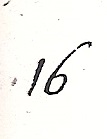
This brings us to the annotation at the top of folio 40 of cahier LVIII of the Mélanges. At first glance the hand does — yet doesn't — resemble the hand that annotated the final pages of CC's three recueils. This is the inscription that CC rightly deciphered as: "Le graveur a les deux feuillets suivants de cette partition qui comprennent Egredimini."

Close scrutiny of Étiennette Charpentier's death inventory permits
me to say with considerable confidence that Guesdon's clerk did indeed
write the annotation in cahier LVIII. Owing to differences in the
darkness of the ink and the thickness of the quill, the two examples
that follow at first appear quite dissimilar. However, that proves not
to be the case. The four lines from the inventory were written at the
end of a long day, by an exhausted clerk who briefly abandoned his
formal hand in favor of his more relaxed everyday script. He used that
same relaxed hand on folio 40.
To demonstrate this, I have circled several words: feuillet (marked in yellow) differs little from the feuillet shown above, from the death inventory. There are other telling similarities between the inscription on folio 40 and the paragraph in the death inventory. For example, the clerk's relaxed hand includes 3 final n's that hook down below the line, toward the left (red). The same leftward hook can be seen on folio 40. The p's — indeed, the pre's (blue) — are the same in both inscriptions. The long looped s's (green) are present in both images. And the capital E of Egredimini (purple) is identical to the E's on Élizabeth and Étiennette in the inventory. In short, the annotation at the top of folio 40 was written by Guesdon's clerk.




One final comparison: Jacques-François Mathas's paraphe.
Mathas was a bourgeois de Paris, and wrote a lovely large hand that presumably reflected his exuberance. (By contrast, the hand of his brother-in-law, Jacques Édouard, suggests a meeker, more self-effacing person.) Mathas was not, however, a professional of the pen: his paraphe lacks the disciplined regularity, from one use to the next, on which scribes and clerks prided themselves and which their professions demanded. There are several dozen of Mathas's paraphes in the papers of the estate, and no two approach being identical, in the manner of the paraphes of notaries and their clerks. Sometimes Mathas's paraphe took the form of a ball, with one or two loops sticking up at the top; sometimes the paraphe was less compact; and sometimes it was a sloppy mess. There are, however, several constants in his paraphes: one (or or occasionally two) of the vertical loops extends from the top of the curlicues; two horizontal loops can always be discerned in the ball of loops; and the paraphe almost always ends with a long tail that extends to the right and finishes with a sort of fish hook. Although two of the three paraphes in CC's images are extremely sloppy, these elements are present.

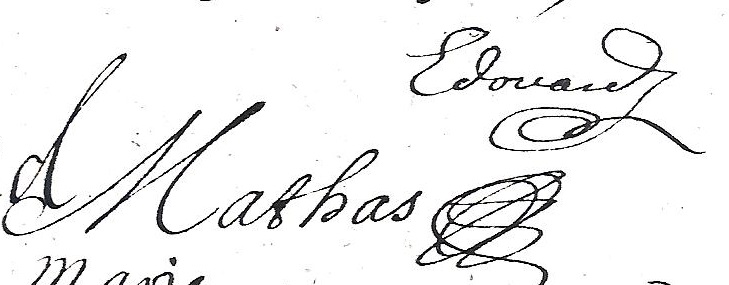
Jacques-François Mathas puts his mark on Marc-Antoine Charpentier's manuscripts
Mathas's gesture of apposing his mark on the papers of his late uncle — much as a cowboy would apply a branding iron to his cattle — and his temerity at allowing the notary's clerk to annotate a page of the papers he and Jacques Édouard had inherited, can perhaps be understood in the context of the psychological torment that Mathas was going through during the first months of 1709.
Several years earlier he had married Marc-Antoine and Étiennette Charpentier's niece, Marie-Anne Édouard, a widow whose late husband had, she would claim, absconded with her rightful possessions and left her penniless. Mathas was expecting to receive a sizeable bequest from Étiennette Charpentier, in return for having married Marie-Anne. But the elderly linen-seller simply would not die!
Mathas lost all patience. He tried to coerce Étiennette to "give" him all her property (presumably by a notarial act known as a donation entre vifs). If she refused, he screamed, he would "hit her so hard on the head that she would never recover, and he would set fire to her house." At Christmas time 1708 — shortly before the arrival on January 5, 1709, of the Great Winter that saw temperatures in Paris drop as low as -20o C (4o F) and remain below -10o C (14o F) for two full weeks (2) — Mathas again came to insult his wife's aunt, asking: "Who is going to reward me for having married her penniless niece?"
As hyperthermia and respiratory ailments caused mortality rates to
climb, and as grain prices began to soar and a financial crisis shook
the royal government, Étiennette Charpentier's relations with Mathas
deteriorated. On January 16, 1709, she called the police. Mathas had,
she said, pounded on her door six times that day, shouting insults that
could be heard by the entire neighborhood. (3)
Was it the extreme cold, combined with the emotional wounds to which
Étiennette was subjected in January 1709, that sent the aged
linen-seller to her deathbed two months later?
Described in the police report as an "homme violent et très dangereux," Mathas may well not have lamented Étiennette's death. Indeed, he may have rejoiced, dreaming about the fortune that would soon be his: half the contents of the apartment and shop, and half of Étiennette's silver and jewelry. (4) He may also have dreamed of raking in a small fortune by selling or otherwise exploiting Marc-Antoine Charpentier's compositions. (The composer's heirs are said to have believed that the manuscripts would bring in a sum almost as large as the proceeds from Étiennette's estate: "Les héritiers de Monsieur Charpentier ont refusé quatre mille livres de tous ses ouvrages, on les cedera à moins aujourdhuy" noted the compiler of the Mémoire of Charpentier's works, drawn up in 1726.)
When the Great Winter struck, Mathas and Jacques Édouard were deeply involved in a publication venture that would, they hoped, lead to the patronage of Charpentier's former pupil, Philippe d'Orléans, then duke of Chartres and now duke of Orléans. Jacques Édouard had been received as a maître libraire on January 16, 1706, but he was not a master printer nor did he own a print shop. For this publishing venture, as for any publishing venture throughout the realm, Édouard had to apply for a privilège from the royal administration. Obtaining that authorization often required asking a powerful person to allow the book to be dedicated to him or her. (5) In other words, early in the venture, through one of the duke's household officers Édouard requested that the duke of Orléans do him this great honor. Once the privilège was granted, Édouard could farm out the actual printing job "to any bookseller or printer he wishes to choose." (6) As a final step, he had to deposit several copies of the book at the different royal libraries. Only then could he sell the books in his shop. (He could also sell books published by other libraires or imprimeurs.)
For Édouard and Mathas's joint venture, a dozen religious pieces with Latin texts had been selected from among their late uncle's manuscripts, to be reproduced in an oblong book titled Motetz melêz de symphonie. During the Great Winter, Claude Roussel was engraving the scores for the twelve works. The final page informs the public that he finished the engravings on March 9, 1709, just two weeks prior to Étiennette Charpentier's death. Engraving the music was the only way to circumvent the monopoly of the Ballard family, which covered "printed" music but did not extend to impressions made by engraved plates. Roussel was renting to them (7) an ornate engraved plate (a frontispice that incorporated a titre) (8) showing musical instruments that had been used for at least two other publications. He modified it slightly, to include the duke's coat of arms. (9) The privilège itself was finally granted on March 23, the day after the linen-seller's death.
In short, on March 23, 1709, Édouard and Mathas (and his wife, Marie-Anne Édouard) became the official owners of what we call the Charpentier Mélanges; and, presuming that they had sufficient cash to pay Roussel, they had taken possession of the engraved music plates for the book. The privilège, however, was in the name of Jacques Édouard, alone. Was Mathas troubled about this? Did he feel vulnerable? For example, did he fear that at some point during the ten years covered by the privilège, Édouard might snatch away this potentially lucrative project and keep all the profit for himself? It cannot be ruled out: Mathas was very testy and contestatory throughout the notarial procedures.
One wonders if Mathas and Édouard understood the nature of the pieces being engraved. Were they relying on the taste of someone more knowledgeable than they about music? That is to say, in their dedication to the duke, they linked these twelve pieces, all of them devotional, to the duke's "amusements" while still a child or an adolescent. Amusements denoted useless activities, wasted time, and vain hopes — although it could mean something slightly more serious: amusing oneself by conducting experiments in physics. (10)
One also wonders whether the duke ever heard one or another of those pieces performed. It is highly unlikely that he heard the works written while he was a youth. For example, Ave regina coelorum (H.22) almost certainly dates from1677 and was composed for Guise devotions. The duke was only three years old at the time; nor is there evidence that he visited the Hôtel de Guise prior to Mlle de Guise's death in 1688. Panis angelicus (H.243) was likewise written for Guise devotions, circa 1679, when the prince was only five years old. And, although the duke was sixteen when Charpentier composed his Motet pour St François de Borgia (H.354) -- the piece appears to have been written for October 1690 -- there is no evidence that the duke attended devotions that year at the Jesuit church of Saint-Louis, the Jesuit Novitiate on the rue du Pot-de-Fer, or the chapel at the Jesuit Collège de Louis-le-Grand. The duke's lessons in composition with Marc-Antoine Charpentier would not take place until several years later, 1692-93.
Taking Étiennette Charpentier's death inventory
Let us return to Étiennette's apartment on the day of her death, March 22, 1709, shortly after her executrix deposited the lingère's autograph will at the nearby office of Notary Guesdon.
Françoise Ferrand, widow of René Lefebvre de la Falluère, first president of the Parlement of Brittany, had been born into a family of lieutenants civils, high officers at the Châtelet (the official entity that had recorded Étiennette Charpentier's complaint and that now, through its notaries and its lieutenant civil, was supervising the liquidation of her estate). She would have been familiar with all the ins and outs of the notarial world; and owing to her late husband's rank, she would have intimidated even irascible Jacques-François Mathas who, assisted during the scellé by a procureur from the Châtelet, repeatedly contested the steps being taken and complained vehemently about Jacques Édouard's claim to be his "creditor."
Once all the doors in the apartment had been sealed and the principal furnishings of each room had been described, it was time to begin the inventory. This activity, which began on April 5 and ended on April 13, consumed five full working days and three half-days. The final day was fraught with tension: a second autograph will had been found a few days earlier and had been taken to the Châtelet for examination by the lieutenant civil. On April 13, the lieutenant civil came to the rue des Noyers and informed the assembled heirs and inventory-takers that the document said exactly the same thing as the autograph will that Françoise Ferrand had brought to the notary back on March 22. In short, the will deposited with Notary Guesdon was valid. Jacques and Marie-Anne Édouard would each receive half the estate, after payment of the usual pious bequests. Jacques-François Mathas's hopes were, however dashed: the will stipulated that he and his wife would receive no money from the estate until outstanding debts on Marie-Anne's linen shop had been deducted from her share. (In the end, the cash payment to Mathas and his wife totaled a mere 183 livres.)
A scellé sometimes contains information that is not in the inventory. For example, Étiennette's scellé mentions two "family portraits," but the inventory does not refer to them. Frustratingly, neither her scellé nor her inventory alludes to the presence, in that apartment, of even manuscript notebooks or recueils of Marc-Antoine Charpentier's music. For this reason, I earlier proposed (11) that Édouard had already taken the manuscripts to his shop near Notre-Dame cathedral. But thanks to CC's questions, we learn that some, if not all of the Mélanges were still in Étiennette's apartment between April 5 and April 13. Since the lodging was being emptied of all its furnishing in late April and early May, we can state with certainty that the papers were removed from the lodging on the rue des Noyers well before the end of May. In short, by late May 1709, the Mélanges had been transferred to the shop or lodging of Jacques Édouard, located in the open area (parvis) in front of Notre-Dame. (Jacques-François Mathas and his wife lived in the cul de sac of Sainte-Marine, only a few streets away from the parvis.)
Jacques-François Mathas's paraphe can be seen on three of the four images. This means that Mathas actually touched those particular manuscripts at some point. He was stating his approval or his ownership of the object, just as he had throughout the long, slow notarial process, when he affixed to the notary's minute his name and paraphe (or sometimes only his paraphe). In other words, in early April 1709, Mathas understood full well the implications of affixing one's paraphe to a piece of paper. The very act of doing so meant that he was staking a claim, claiming ownership, approving an action.
We have also seen that the handwriting of Notary Guesdon's clerk appears in all four of CC's images. These annotations can only have been made in Étiennette's lodging, presumably between April 5 and April 13, 1709, while the inventory was being compiled.
But these papers were not, however, on the inventory itself. In other words, Mathas appears to have asked the clerk to examine, evaluate and/or collate some of the Charpentier manuscripts during his free moments.
At this point, the story becomes interesting — and almost amusing.
The clerk set to work and conducted himself exactly as one might expect a member of the notarial profession to behave. The mission of a notary is to be a "note-keeper," a garde-nottes. During an inventory, each item in a room is enumerated and is given an approximate value that may or may not reflect the actual market value. For example, if the deceased's library was too small to summon a libraire to make an inventory, the notary tended to appraise small, slender books at 1 or 2 livres, somewhat larger books at 3 to 4 livres, folio or multi-volume works at 6 livres, and so forth. Personal items such as portraits or manuscripts were generally not mentioned or evaluated. (12)
When a clerk came upon a handwritten register or "notebook" (cahier) that reflected the deceased's financial activities, he would count the number of "feuillets" to ensure that no one could subsequently remove pages. (Remember, his goal was to preserve the integrity of the volume, not to make sense of its contents.) Thus, when Guesdon's clerk encountered Étiennette's record books (titres 7 and 8), he proceeded to count the feuillets: "A register ... containing two hundred and ninety feuillets, the first one hundred and seventy-three of which are in the deceased's hand...." He continued in this vein for eight dense pages, during which every crossed-out or interpolated word was recorded ("the twenty-fourth feuillet is crossed out, with the exception of three items...").
This mind-set helps us understand why the clerk was preoccupied by the number of feuillets in the three oblong recueils, yet did not mention the contents of the little music books. The same preoccupation with feuillets characterizes the clerk's approach to cahier LVIII. Having apparently been asked to collate that cahier with Charpentier's now-lost "repertoire," he searched for missing feuillets. His search was rewarded. At the top of folio 40, he noted that "Le graveur a les deux feuillets suivants de cette partition qui comprennent Egredimini..." (The engraver has the two next feuillets of this score, which include Egredimini). Egredimini Filiae Sion (13) is one of the works that Roussel had engraved for the forthcoming Motets melêz de simphonie. In short, either Édouard or Mathas, or both, were doing everything possible to prevent Marc-Antoine Charpentier's papers from being dispersed. The clerk was hired to verify whether any compositions had gone astray as a result of the engraving project. No paraphe accompanied this marginalia.
Mathas in particular seems to have been keeping close watch over the Charpentier manuscripts. Was he doing this surreptitiously? The clerk's collating and counting of feuillets appears to have rapidly ended. Did Mathas conclude that it was useless — as well as costly — to simply count the number of feuillets? Did the executrix become suspicious and put a stop to the project? The fact that Mathas put his mark on three recueils, but Édouard did not, suggests that something was going on behind Édouard's back, perhaps during the daily two-hour lunch breaks.
Paraphes on the Motets meslêz de Simphonies
A few days after her initial email — while we were keeping our two heads together via email and trying to weigh this new evidence — Catherine Cessac informed me that, in the copy of Motets melêz de simphonie at the BnF, available on Gallica.fr, the paraphes of both Jacques Édouard and Jacques-François Mathas (circled in red) appear at the bottom of page 1. Here is page 1 of the copy bearing the call number Vm1 1137.
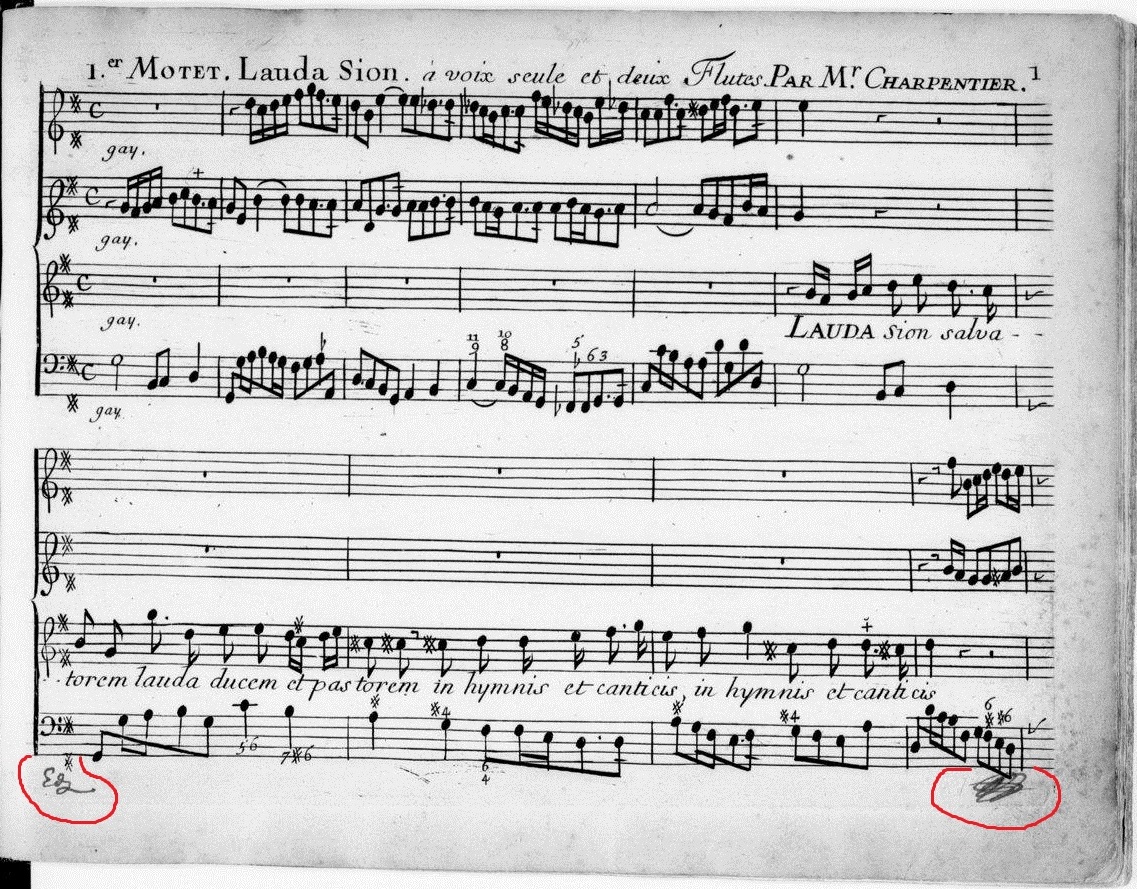
This raised more questions. CC answered my call for help by
photographing key pages of the copy bearing the call number D 1928.
There were the same paraphes, on the bottom of page 1. In other
words, for each copy, both men attested to the authenticity of the
compositions, their ownership of the original manuscripts, and their
material participation in the project.
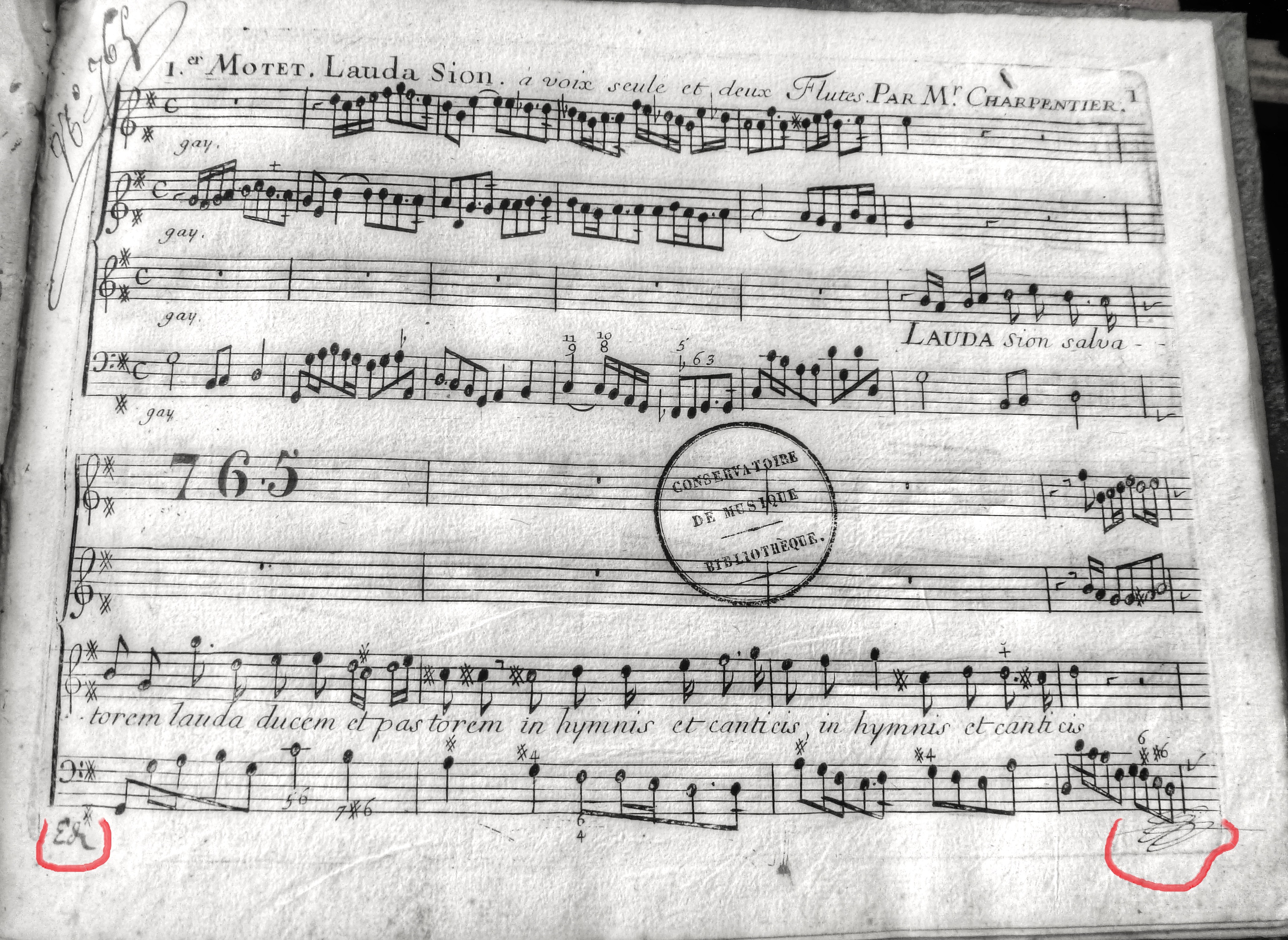
At this point a hypothesis began to take shape about why these two copies bear paraphes. Stamps on the books reveal that both copies were once part of the collections of one or another royal library. Vm1 1137 is twice stamped "Bibliothèque Royale," and the dedication page of D 1928 is stamped "Menus Plaisirs du Roy, Bibliothèque de Musique." In other words, these two copies were among the four books that Édouard and Mathas were obliged to deposit in the royal collections. The privilège reads:
avant de les [the books] exposer en vente, il en sera mis deux Exemplaires dans nôtre Bibliotheque publique, un dans celle de nôtre Château du Louvre, et un dans celle de nôtre tres-cher et feal chevalier, Chancelier de France, le sieur Phelipeau Comte de Pontchartrain, Commandeur de nos ordres.
We can be even more precise. Vm1 1137 clearly is one of the two books deposited at the "Bibliothèque publique," that is, the Bibliothèque Royale situated on the rue Vivienne. Prior to finding its way to the Music Library of the Menus plaisirs (presumably at Versailles), D 1928 was on the shelves of either the library at the Louvre or the library at the Chancellerie. It was the Chancellerie that supervised the book trade, primarily through granting a privilège to publish the work and then, after publication, examining the contents to either approve or censure the book. (14) (After the founding of the Conservatoire in 1795, D 1928 was incorporated into its library.)
Close scrutiny of the scans of the frontispices of the copies at the BnF (I regret not being able to go to Paris and examine them close up) suggests that in both books the titre was printed on a small, octagonal-shaped piece of paper that was then glued onto the frontispice, to form the requisite titre. These little printed papers almost certainly were produced by the same printer who set the type for the dedication, the list of works, and the privilège: the fonts are the same. In other words, the two books are contemporary with one another and date from 1709.
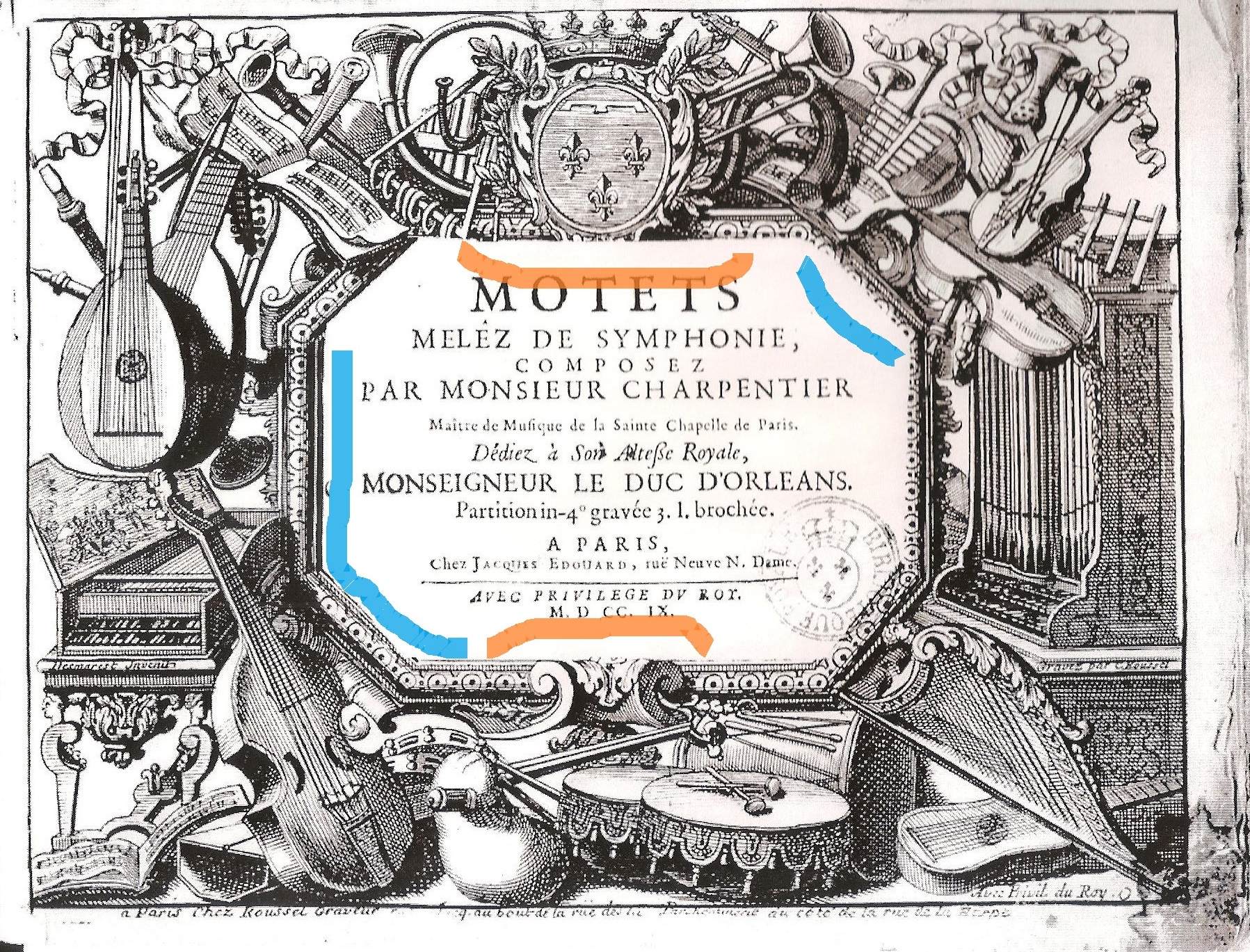
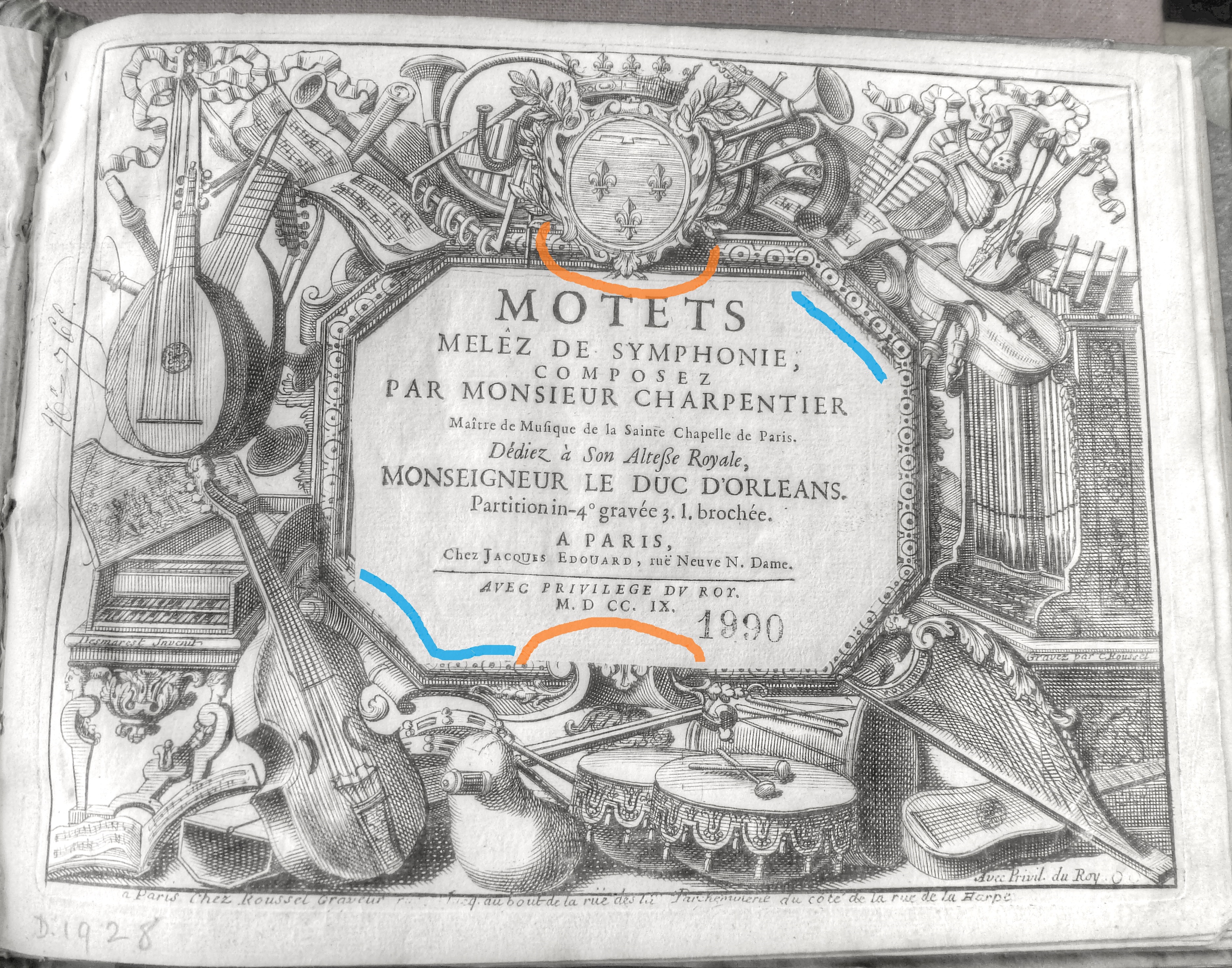
It is rather surprising to note that, in neither book, was the octagonal piece of paper placed precisely over the gadroon frame at the center of the engraved frontispice. Instead, they were pasted on, slap-dash! As the orange marks in these two images show, in Vm1 1137, the glued titre completely covers the frond at the bottom of the arms of the duke of Orléans, but it reveals the two volutes at the bottom of the gadrooned frame. By contrast, in D 1928 the frond at the base of the coat of arms is almost entirely visible, but the volute at the bottom is almost totally concealed. The blue lines show that, in Vm1 1137, much of the gadroon border along the upper right-hand portion of the octagonal frame is concealed by the glued-on titre, while the gadroon at the bottom left is entirely visible. In D 1928 most of the gadroon along the bottom of the frame is covered by the titre.
At this point, a summary of my observations about the two books with paraphes is advisible:
--- First, we know from the stamps that the books were part of what we today would call the dépôt légal, that is to say, they were among the four copies submitted to one or another of the royal libraries.
--- Second, both books were both marked with paraphes. These paraphes become very significant when we recall that, to one of the copies of Éléments ou Principes de musique that he submitted to the royal libraries, Marc-Antoine Charpentier's colleague, Étienne Loulié, added his signature and paraphe to the engraving of the chronomètre that he had invented. (15) In other words — at least in these two instances — marking a paraphe on a book one was submitting to the royal libraries was a way of proclaiming one's ownership of the things being discussed in the book. Loulié owned the chronomètre and had a model of it in his apartment; Édouard and Mathas owned Charpentier's papers. I may be wrong, but I think it unlikely that Édouard and Mathas marked with paraphes every copy of Motets meslêz put on sale in Édouard's little shop.
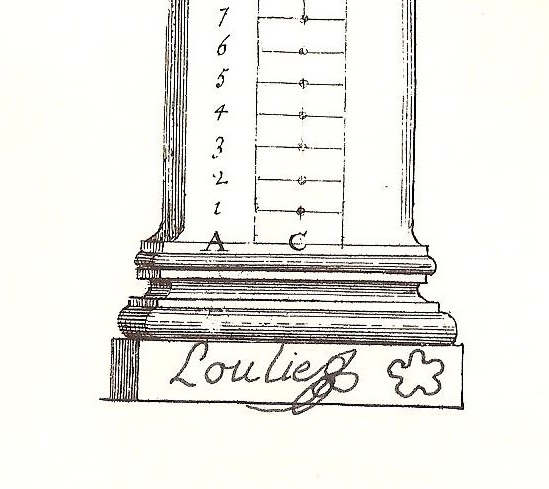
--- Third, although the titre of both books is poorly centered in the octagonal space at the center of the frontispice, these printed titres contain the requisite information that the Chancellerie expected to be provided in the titre at the beginning of the book:
MOTETS/ melêz de symphonie,/ par Monsieur Charpentier/ Maître de Musique de la Sainte Chapelle de Paris/ Dédiez à son Altesse Royale,/ Monseigneur le duc d'Orleans/ Partition in-4o gravée 3. l[ivres] brochée. A Paris,/ Chez Jacques Edouard, ruë Neuve N. Dame/ [horizontal line]/Avec Privilege du Roy/. M D CC IX/.
The copies sold at Édouard's shop presumably had the same titre glued onto the frontispice. Without this information the books could not have been sold.
I have said little thus far about the third surviving copy of Motez melêz de simphonie, which was acquired by Emmanuel Mandrin from the estate of Geneviève Thibault de Chambure. (16) The book differs from the other two copies in several extremely significant ways:
--- First, there are no stamps like the ones the royal libraries marked on books from the dépôt légal. Indeed, we shall soon see that this particular copy bears a very different sort of "stamp."
--- Second, the owner assures me that there is "aucun [paraphe] au bas de la page 1, ni nulle part ailleurs." The reason for this omission will soon become clear.
--- Third, although the engraved frontispice is the same, the actual title is handwritten, not printed. Indeed, it is calligraphed. In addition, the wording of the titre — which was written directly onto the engraved sheet — is markedly different. It reads:
Premier Livre/ de/ MOTETS/ melez de simphonie/ dediez/ a son Altesse Royalle/ Monseigneur/ Le Duc d'Orleans/ composés/ Par M. Charpentier/.

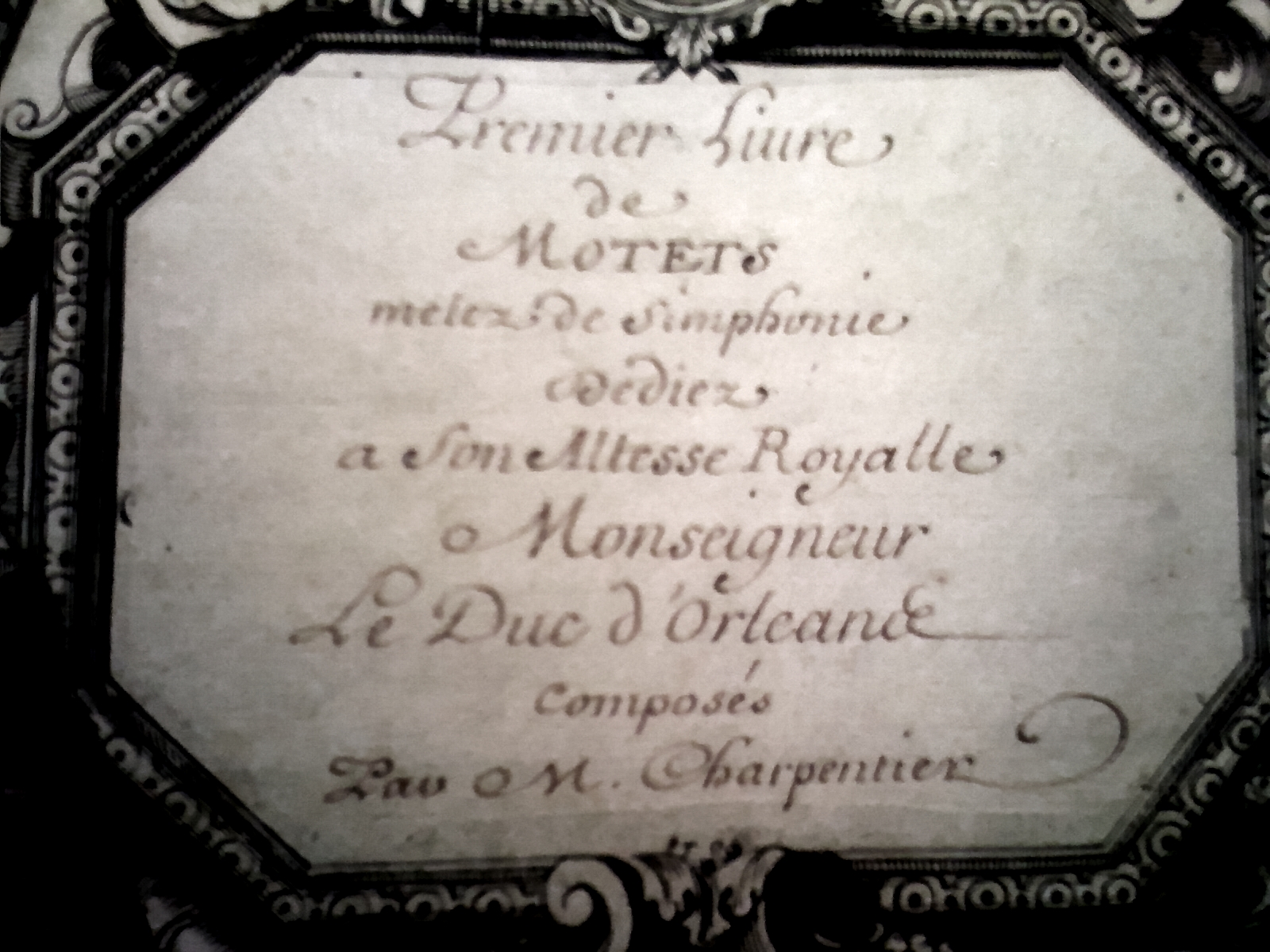
In other words, priority is given the the duke of Orléans and his late teacher — and to the possibility that this book is but the "first" in a series. (17) The commercial information has been omitted: the publisher, the location of the shop, the price, the date, the allusion to the privilège. Without that requisite information, the book could not have been offered for sale!
With that exclamation, we arrive at the heart of our investigation of the three copies of Motets melêz de Simphonie. And we resume our analysis with the phrase, "the book could not have been offered for sale!"
This third copy clearly was not intended for sale. It was intended as a gift to a prince. This is reflected in the handwritten titre, which omits the routine world of shops and focuses instead on the prince and his late teacher. For example, the book bears no price: the prince was not likely to stroll to the parvis of Notre-Dame and buy it. The book bears no paraphe: it would have been unseemly for Édouard and Mathas to place their personal marks on an object meant for a prince. And no stamp of ownership was placed on the pages: it would have been superfluous because the cover bears the "stamped" coat of arms of Philippe II d'Orléans, the prince to whom the book is dedicated.
The book belongs to a very select category of books: the presentation copy, the "exemplaire de dédicace" that a publisher or an author offered to the dedicatee. The typical exemplaire de dédicace was professionally bound, usually in dark red morocco leather with gold tooling showing the dedicatee's coat of arms. The tooling was as elaborate as the donor's pocket permitted.
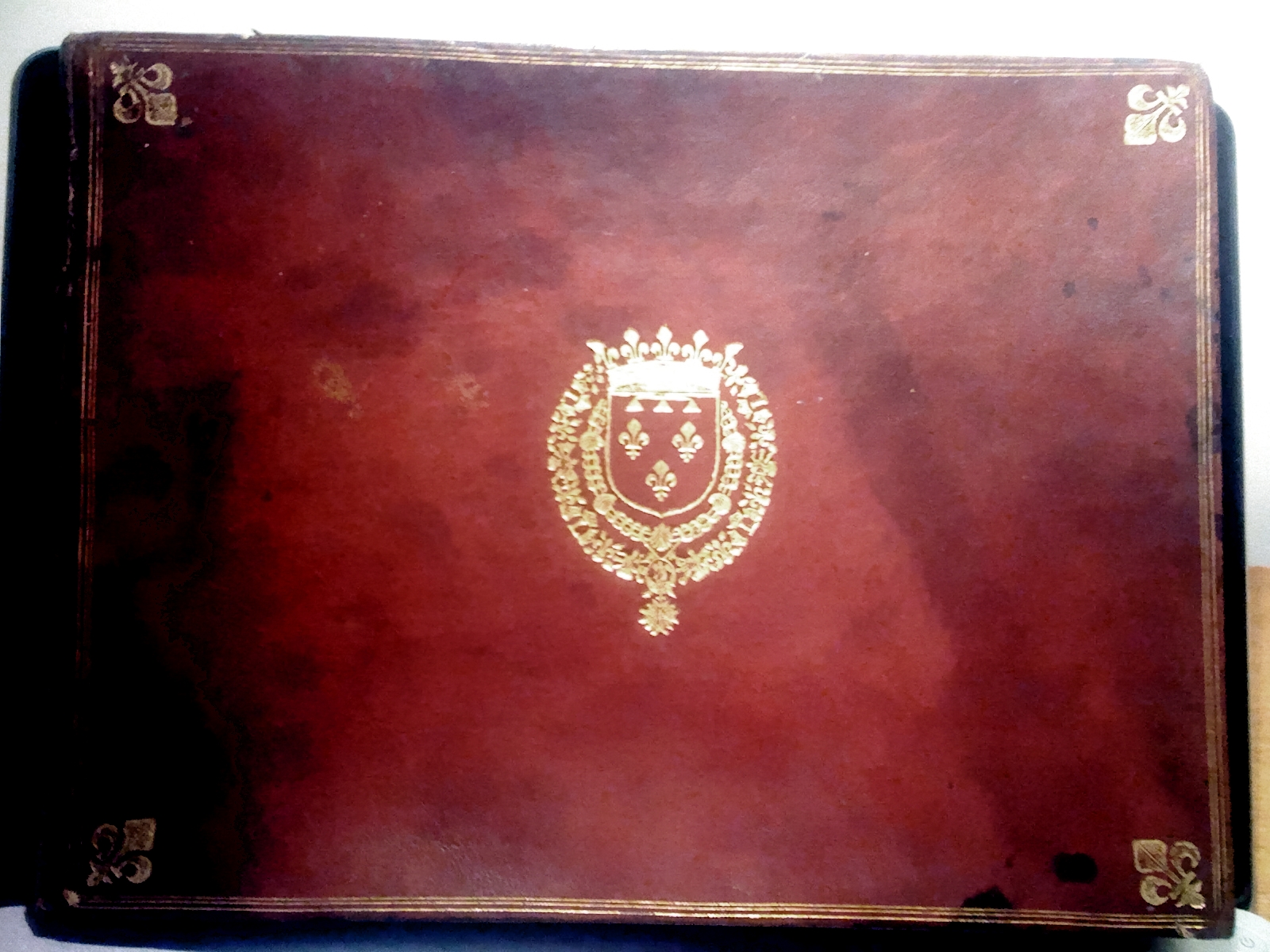
Thus, like so many exemplaires de dédicace, this third copy of Motets meslêz is bound in red morocco leather that has darkened to what the owner describes as "maroquin bordeaux." As was customary with exemplaires de dédicace, it is emblazoned in gold leaf and shows the coat of arms of the dedicatee, Philippe II d'Orléans. Édouard and Mathas almost certainly did not have the book bound cheaply by one of Édouard's associates. (18) Quite the contrary, they had little choice but seek out the exclusive bookbinder who possessed an "iron" showing the duke's arms.
In sum, this volume is the exemplaire de dédicace that Édouard and Mathas presented to the duke of Orléans and that became an integral part of his princely library.
It can therefore be ruled out that this third copy was printed after the publication of the two copies at the BnF, which can only date from 1709. Indeed, it seems safe to conjecture that the presentation of the exemplaire de dédicace was separated from the delivery of the books to the royal libraries by a few hours or, at most, a day — the visit to the Palais-Royal doubtlessly occurring first, as protocol dictated.
Coda
My research does not permit me to say whether Jacques Édouard
remained on amicable terms with his irascible brother-in-law. I could
find neither Mathas's notary nor Édouard's. Édouard was still selling
Motets meslêz de Simphonies in 1715.
(19) I did however learn enough about Jacques Édouard's business
ventures to say that nothing he did seemed to prosper. He was
approximately seventy-six years old in 1752, when the records of the
libraires described him thusly: "C'est un pauvre misérable qui ne
vend que des bouquins." (20) (He is a poor wretch
who sells only bouquins.) The French Academy defined a bouquin
as "un vieux livre qui n'est guere estimé."
"Two heads are better
than one..."
Notes:
1. This Musing, and its comparison of handwriting, is based on
the following notarial documents for Étiennette Charpentier's estate:
AN, MC, Y10830, March 22, 1709, scellé of her apartment and shop;
XXIII-399, inventaire, April 5, 1709; and XXIII-399, quittance, April
27, 1709.
2. See P.D. Jones, "The Great Winter of 1709," in P.D. Jones et al, eds., History and Climate: Memoires of the Future? (New York, 2001), p. 207; and W. Gregory Monahan, Year of Sorrows (Columbus: Ohio State Press, 1993), chapters 3 and 5.
3. AN, MC, Y 10830, "scellés," Jan. 19, 1709, "Plainte pour Éstiennette Charpentier fille majeur contre Jacques Mathas." For the text, see my transcription of Etiennette's Complaint.(which will eventually be re-formatted and re-published to this site, among the "Fugitive Pieces."
4. The fabrics in Étiennette's shop, alone, were estimated as worth 6657 livres, her silver and jewelry were estimated at 862 livres, and the notaries found 507 livres in cash. These three items alone total 8028 livres (I did not compute the estimated value of her furniture.) An overly optimistic heir could therefore imagine that her worth approached 10,000 livres. Reality painted a different picture: Jacques Édouard got 2301 livres and Marie-Anne 2440 livres, 2257 of which went to pay her debts. Pious bequests totaled 1020 livres, for a grand total of 5761 livres. These numbers doubtlessly should be taken with several grains of salt, or perhaps the executrix disbursed some of the money privately: indeed, family finances as laid out in notarial documents often do not "add up."
5. See the letter from Père de la Chaize to Mme de Guise, October 15, 1682, in which he asks her to "lend her name" to the publication of a book, BnF, ms. fr. 17050, fol. 279.
6. "... tel libraire ou imprimeur qu'il voudra choisir" is the expression employed in a privilège he was awarded but apparently never used, BnF, ms. fr. 21947, July 26, 1705.
7. That is to say, the plate had been used in 1705 for Dandrieu's Livre de clavecin (with the coat of arms of the dedicatee, the Chevalier Robert, whose coat of arms seems to show a cow or a goat with a flowered crown); it was again used in 1706 for Rameau's Pièces de clavecin (I have not been able to view that particular version of the frontispice); and it would be reused in 1713 for Salomon's Jason (where the "label of three points" above the fleurs de lys on the Orléans crest was removed, leaving the three fleurs de lys of the Bourbon king in whose "academy" the work was performed).
8. A misleading vocabulary is being used in discussions of this frontispice. Curiously, the entire page is being described as a "cartouche" with a badly-centered "vignette." Historians of the early-modern book would describe the page as an engraved "frontispice" with a pasted-on, typeset "titre." From the first edition of the Dictionnaire of the French Academy (1694) and all the way to present-day online dictionaries, cartouche has signified a "sorte d'ornement de sculpture ou de peinture qui represente un rouleau de carte coupée et tortillée." Bits of such twisted rolls can in fact be glimpsed in the frontispice, but the surrounding instruments occupy as much, if not more of the plate's surface than does this cartouche. Only by a stretch of the imagination can the entire frontispice be described as a "cartouche." The word vignette is equally troublesome. Since well before 1694, it has denoted a "petite estampe qui a plus de largeur que de hauteur, et où l'on ne gravoit autrefois pour l'ordinaire que des pampres et des raisins, et où l'on grave aussi presentement toutes sortes d'autres figures. Les Imprimeurs mettent des vignettes pour ornement au commencement des livres et des chapitres." There are, of course, no vignettes on the frontispice of Motets melêz. When people use that word for the printed titre, are they thinking of the little insurance "stickers" that the French today affix to their windshields? This new meaning of vignette first appeared in French dictionaries in the early twentieth century. Or are they giving vignette the meaning that Littré described as "contemporary" in 1872 and that is employed by art historians: "On donne ce nom aujourd'hui aux estampes mêmes qui occupent toute une page, quand elles sont entourées d'un cartouche"? For the evolution of the frontispice and the titre, see Henri-Jean Martin, La naissance du livre moderne, Mise en page et mise en texte du livre français (XIVe-XVIIe siècles (Paris: Cercle de la Librairie, 2000), pp. 360-363.
9. For Roussel and his engraving style, see Shirley Thompson, "Charpentier's Motets melêz de simphonie: a Nephew's Tribute," in New Perspectives on Marc-Antoine Charpentier, ed. S. Thompson (Farnham: Ashgate, 2010), pp. 290 ff. Her notes 12, 13 and 14 should not be overlooked.
10. Dictionnaire of the French Academy, 1694, "Amuser."
11. See Shirley Thompson's summary of my earlier position in "Charpentier's Motets meslêz de Simphonie," p. 300ff. I want to repeat here that I concur with virtually every correction she makes to my earlier hypotheses. It is wonderful when a hypothesis can be rejected in favor of new evidence, or at the very least a considerably less hypothetical argument. In fact, I see a hypothesis is a very useful tool: by calling attention to an issue, it can impel another scholar to seek an answer. That is why I say, "Two heads are better than one...."
12. For example, Étienne Loulié's manuscripts (which were subsequently passed on to Sébastien de Brossard) were not mentioned in his death inventory, Patricia M. Ranum, "Étienne Loulié ...," Recherches, 26 (1988-1990), pp. 29, 42-47.
13. The piece apparently was retrieved from Roussel, because Egredimini is mentioned in the Mémoire of 1726 as present in the gros cahier. It subsequently disappeared. For the gros cahier and the pieces for Motets melêz that it contained, see Thompson, p. 300ff. Egredimini appears to have once been part of cahier LIX (now missing), which probably contained pieces written in 1692. See Catherine Cessac et al, "Chronologie raisonnée des manuscrits autographes de Charpentier, Essai de bibliographie matérielle," Bulletin Charpentier, special number, 2010-2013, available online from the site of the Centre de Musique Baroque de Versailles. Cessac writes, p. 16: "L' 'Egredimini filiae Sion,' H.280 (s'il s'agit bien de la même pièce) ne nous est parvenu que grâce au recueil gravé de motets de 1709 ... Jacques Édouard aurait-il amputé le cahier de son oncle pour donner le motet au graveur? Un autre feuillet semble également manquant entre les f. 35 et 36 [du cahier LVIII] (deux pièces différentes)."
14. See Bernard Barbiche, Les Institutions de la monarchie française à l'époque moderne, XVIe-XVIIIe siécle (Paris: PUF, 1999), pp. 156-159.
15. It can be see in fold-out engraving at the end the Minkoff reprint of the Paris, 1696, edition. There is no doubt about the authenticity of the signature. In other words, Loulié was marking his "property," his "invention," just as Édouard and Mathas were marking theirs.
16. In RISM, this copy is called "F-Pthibalt." I am very grateful to E. Mandrin for his willingness to answer my sometimes importune queries and especially for having sent me the pictures of key pages used in this Musing.
17. The presence of "Premier Livre" on the calligraphed titre and its absence on the printed ones, has prompted the hypothesis that the two versions at the BnF are posterior to the version in the private collection. Perhaps. But I would like to offer another interpretation: "Premier Livre," in large letters, was placed at the top of the calligraphed titre, to catch the duke's eye and serve as a polite hint that a subsidy for an entire series of volumes would be most welcome.
18. For some of the less ornate exemplaires de dédicace presented to Cardinal Mazarin, see Isabelle de Conihout, "Les reliures de Mazarin," in Mazarin, les lettres et les arts, published by the Bibliothèque mazarine (Paris, 2006), especially pp. 288, 290; and for a truly "exuberant" dedication copy offered by some libraires, see Un temps d'exubérance, les arts décoratifs sous Louis XIII et Anne d'Autriche, published by the Réunion des musées nationaux (Paris, 2002), p. 413. Isabelle de Conihout provides evidence about the recompense offered to Henri Albi, S.J., the donor of a fat red morocco-leather book. Described as a "livre donné et dédié," the book has considerably more gold tooling than the binding ordered by Édouard and Mathas. Father Albi was given 50 livres (p. 283). Judging from Naudé's "Grand catalogue" of Mazarin's library, the book was not presented to the Cardinal himself, but to one or another of his librarians. I. de Conihout also points out that one specific fer ("iron") bearing the arms of Mazarin was used between 1644 and 1661 by binder Le Gascon, for a succession of exemplaires de dédicace (pp. 281-284). In other words, the "iron" of a prestigious person tended to be available at only one bindery, and this exclusiveness doubtlessly tended to inflate prices. Another source reveals how an author went about having a dedication approved by Philippe II d’Orléans: a spokesman (in this case the abbé Richard, who was speaking on behalf of the author of a book about dance!) would eventually "par[venir] à se glisser [dans le cabinet du duc] ... et présent[er] au prince l’épître dédicatoire que lui adressait un sieur Bonnet en tête d’une Histoire générale de la Danse sacrée et profane," P.E Lémontey, quoted by Dom H. Leclercq, Histoire de la Régence (Paris, 1921), III, p. 439.
19. The book is mentioned on p. 431 of Édouard's second edition of Pierre Amand's Nouvelles observations sur la pratique des accouchemens... , 1715.
20. BnF, ms. fr. 22107, "Jacques Édouard."